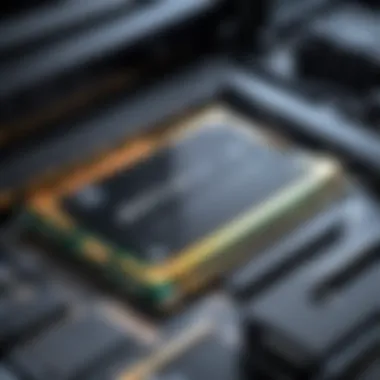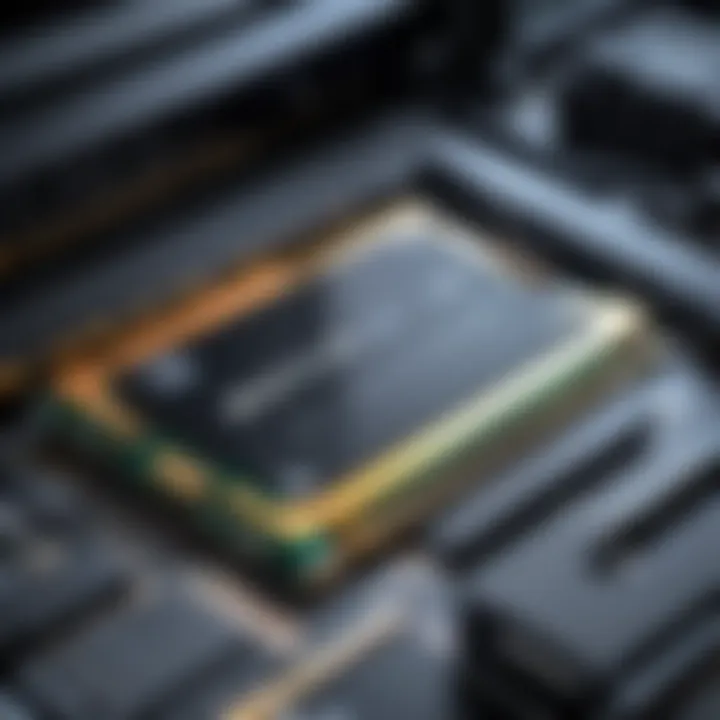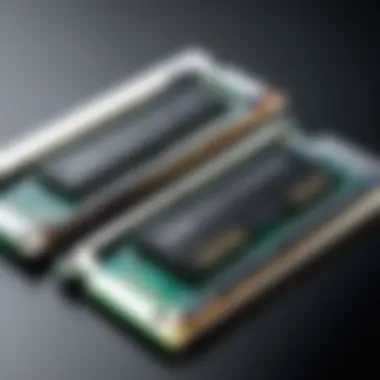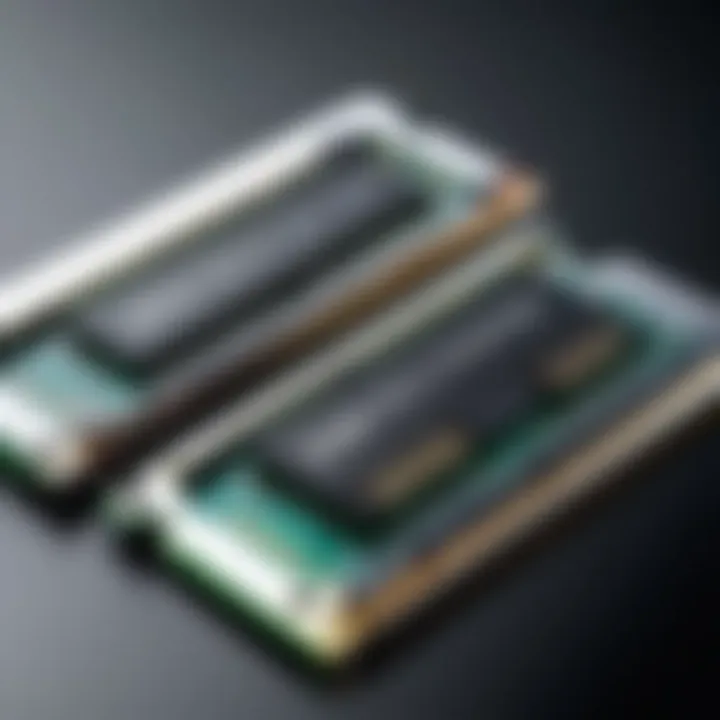Expanding Laptop RAM: Upgrade Your Performance Today


Intro
When it comes to laptops, performance can often feel like a fragile glass figurine—one wrong move, and it can all come crashing down. Many users discover that their trusty laptops can struggle under the weight of demanding applications, whether it's for gaming, graphic design, or heavy multitasking. This leads many to consider an upgrade in their device, specifically focusing on RAM. But why should one bother with such an upgrade? Put simply, increasing Random Access Memory in your laptop can lead to improved performance and responsiveness.
In this guide, we’ll unpack the nitty-gritty of expanding your laptop's RAM. From understanding what RAM even is, to the various options available, we’ll help you make an informed decision about this meaningful enhancement. With the right knowledge, you can ensure your laptop keeps pace with your ambitions, whatever they might be.
Understanding Laptop RAM
In today's fast-paced digital environment, understanding laptop RAM is a cornerstone for improving system performance. As programs become more demanding and multitasking becomes the norm, having adequate RAM can be the difference between a smooth experience and a frustrating one. RAM, or Random Access Memory, acts as a short-term memory bank for your computer, allowing it to store and retrieve data quickly. It's essential to recognize how this memory type functions and its role in the overall operation of your laptop, especially when it comes to upgrade considerations.
By expanding your laptop RAM, you're essentially enhancing its capability to handle various tasks simultaneously, better accommodating modern applications that require more memory to operate efficiently. Understanding the types available, compatibility issues, and performance implications can empower users to make informed decisions about potential upgrades.
What is RAM?
RAM is often described as a computer's working memory. Unlike long-term storage like hard drives and SSDs, which hold data permanently, RAM is where the data temporarily resides when applications are running. When you open a program, it loads into RAM to make interaction seamless and fast. Once you close the program, that data is relinquished from the RAM, freeing up space for new tasks. Without enough RAM, your laptop may struggle to run multiple applications at once, leading to sluggish performance.
Different Types of RAM
When considering an upgrade, it’s important to understand the different types of RAM available, as they affect performance and compatibility significantly.
DDR3 vs DDR4
One key aspect of RAM to dive into is the difference between DDR3 and DDR4. DDR stands for Double Data Rate, and the version number indicates the generation. DDR4 is the newest standard. It offers higher speeds and reduced power consumption compared to its predecessor.
- Key Characteristic: DDR4's increased bandwidth and speed can significantly improve data transfer rates.
- Benefit for this article: For users looking to enhance their laptop's performance, DDR4 is often a preferred choice due to its ability to support newer applications and multitasking features, making it a valuable asset in RAM upgrades.
- Unique Feature: Unlike DDR3, which has a limited speed range, DDR4 can achieve speeds exceeding 3200 MHz, crucial for demanding tasks like video editing or gaming.
- Advantages/Disadvantages: While DDR4 provides enhanced performance, it is also worth noting that it is not backward compatible with DDR3 slots. Therefore, users must ensure their motherboard supports DDR4 before making a purchase.
SO-DIMM vs
Further down the RAM rabbit hole, we encounter SO-DIMM and DIMM.
- Key Characteristic: SO-DIMM, which stands for Small Outline Dual In-line Memory Module, is typically used in laptops, whereas DIMM is more common in desktops.
- Benefit for this article: Understanding this distinction is crucial when planning a RAM upgrade, as the physical size and configuration differ, meaning a mismatch can lead to installation issues.
- Unique Feature: SO-DIMMs are smaller and designed to fit the compact nature of laptops, allowing for efficient use of space.
- Advantages/Disadvantages: While SO-DIMMs are more compact, they generally don't hold the same capacity as DIMMs, limiting the overall memory potential for laptop users compared to desktops.
How RAM Affects Performance
Understanding how RAM influences performance can help demystify why it's such a vital component of your laptop's functionality.
Impact on Multitasking
As users demand more from their machines, the impact of RAM on multitasking becomes extremely relevant. Higher RAM allows maintaining multiple applications in memory without significant slowdowns.
- Key Characteristic: The more RAM you have, the more applications you can run simultaneously without a hitch.
- Beneficial for this article: Many professionals and gamers rely on multitasking; for instance, programming software, graphic design tools, and browsers streamlining tasks creates a seamless workflow.
- Unique Feature: Efficient RAM allocation allows laptops to smoothly switch between these demanding tasks, avoiding frustrating delays each time a new application needs to load into memory.
- Advantages/Disadvantages: On the flip side, having excessive RAM without the proper software requirements might lead to slightly diminished returns. However, for most users, having that additional capacity vastly improves performance.
Performance in Gaming and Applications
Gaming and demanding applications provide another lens through which to view RAM's impact. Fast-paced games or resource-heavy software have specific requirements that can be hampered by insufficient RAM.
- Key Characteristic: Games often need to load vast environments, textures, and states into memory.
- Beneficial for this article: Gamers, in particular, benefit from RAM upgrades that minimize lag, enabling smoother experiences and higher framerates.
- Unique Feature: Certain games are designed to utilize multi-threading efficiently, requiring ample RAM to function correctly, thus making an upgrade essential for an enhanced gaming experience.
- Advantages/Disadvantages: However, simply increasing RAM without upgrading other components like the graphics card or CPU might not yield the desired results, as the overall balance of the system must be taken into account.
Assessing Your Current RAM Configuration
Assessing your current RAM configuration is a pivotal step before making any enhancements to your laptop. Knowing what you already have helps you make informed decisions regarding upgrades, ensuring compatibility and performance improvements. It saves you from potential headaches down the road, as you won't end up purchasing components that won't fit or work properly with your system.
Determining Installed RAM
Windows System Information
In Windows, users can easily check how much RAM is installed by accessing the System Information tool. To do this, you can right-click on "This PC" or "My Computer" and select "Properties." This will display not just the RAM amount, but also other vital details like your processor and system type.
A key characteristic of this approach is its simplicity. It caters to users who might not be tech-savvy, providing a straightforward glance at system specs without needing to dive into anything complicated.
The unique feature here is the user-friendly interface of Windows, where important information is bundled in one place, making it a beneficial choice for quick assessments. However, one disadvantage might be that this method doesn’t break down how much RAM is actually being used in real-time.
macOS About This Mac
For Mac users, the process is quite similar. You can easily determine installed RAM by clicking the Apple icon in the top left corner and selecting "About This Mac." This provides a clean interface displaying your system’s specifications, including how much RAM is installed.
The key characteristic of the "About This Mac" option is its elegant layout. It organizes the information neatly, making it easy to understand even for those who are not particularly tech-savvy.
Many find this option to be popular because it quickly provides a snapshot of essential details and is easily accessible with just a couple of clicks. However, similar to Windows, it lacks deeper insights regarding RAM usage over time, which could be a point of concern for users looking to analyze their system’s performance.
Understanding RAM Usage


Analyzing Task Manager
When it comes to understanding how your RAM is being utilized, the Task Manager in Windows is invaluable. By pressing Ctrl + Shift + Esc, you can access this tool and navigate to the "Performance" tab. Here, the RAM usage is displayed along with various charts depicting real-time consumption.
The distinctive feature of the Task Manager is its ability to display various performance metrics in a single view. This makes it a go-to option for users wanting an overview without getting lost in technical jargon. The ability to see which applications are consuming the most memory can significantly help in managing tasks.
On the downside, some users might find it slightly overwhelming due to the myriad of details available. For those less familiar with computing, it can be a tad daunting.
Real-Time Monitoring Tools
Real-time monitoring tools provide a more nuanced understanding of RAM usage. Software like CPU-Z or HWMonitor allows users to track memory consumption over time, which can reveal patterns and peaks in usage that may not be apparent in the built-in tools.
One of the most appealing aspects of these tools is their ability to show detailed statistics, including memory frequency and usage across different applications. Users keen on optimizing performance will find these insights beneficial.
However, the downside is that some of these tools can be complex for the average user. They may offer more data than necessary, which can lead to confusion if one isn't sure what to look for.
Identifying Maximum RAM Limitations
Motherboard Specifications
Every laptop motherboard has specifications that dictate the maximum amount of RAM it can support. Understanding these limitations is key to ensuring that your upgrade efforts are not in vain. You can usually find this information in the laptop's manual or the manufacturer's website.
A critical characteristic is that this is a straightforward way to avoid compatibility issues. Knowing your laptop's limitations helps you select the right RAM modules.
However, the flip side is that not every manufacturer provides clear documentation. This can leave some users guessing, which may lead to buying incompatible components.
Operating System Constraints
Operating systems also impose their own limitations on RAM usage. For instance, the 32-bit versions of Windows restrict RAM usage to around 4GB, while 64-bit versions can handle much more. Knowing your OS's capabilities is essential when considering an upgrade.
A major advantage of being aware of these constraints is that it prepares you for what you can expect post-upgrade. By understanding how much RAM your OS can actually utilize, you ensure that your investment in additional memory aligns with system performance outcomes.
Conversely, some users might overlook this detail, thinking more RAM equals better performance without acknowledging what their OS can support. This can lead to wasted investment in hardware that will not perform to expectations.
Choosing the Right RAM for Expansion
Choosing the right RAM for expanding your laptop is a crucial step towards maximizing your machine’s performance. The dimensions of RAM can often feel overwhelming, especially with various types, specifications, and brands on the market. However, making informed decisions about RAM expansion can drastically improve your laptop’s efficiency and longevity. It’s akin to choosing the right fuel for a high-performance engine; the better the fuel, the better the performance. This section delves into key considerations and options to explore while selecting RAM that aligns with your specific needs.
Compatibility Considerations
Manufacturer Guidelines
When it comes to expanding your laptop’s RAM, manufacturer guidelines are a cornerstone to ensuring successful upgrades. Every laptop comes with a set of instructions embedded in the owner's manual or available on the manufacturer’s website. These guidelines provide crucial information on the type of RAM compatible with your system.
One of the defining features of manufacturer guidelines is their emphasis on specific brands and models of RAM. This ensures that you’re choosing memory that is not only compatible but performs well with your device’s architecture. An advantage of closely following these guidelines lies in the reduced risk of installation errors or, worse, hardware malfunctions.
However, relying entirely on manufacturer specifications can sometimes limit your options. For instance, there might be third-party RAM that offers better performance but is not officially recognized by the manufacturer. Thus, while these guidelines are beneficial, they should not wholly dictate your choices unless you are risk-averse.
Specifications Matching
Specifications matching is another significant aspect of the RAM expansion process. It involves aligning the new RAM modules with your existing ones in terms of speed, size, and latency. This process can be complex. However, it mainly revolves around two key characteristics: speed and form factor.
For instance, if your laptop uses DDR4 RAM modules, it'd be wise to select new RAM pieces with similar specifications. This ensures that the memory operates harmoniously, avoiding any potential bottlenecks. The primary advantage of specifications matching lies in its ability to enhance overall system stability and performance, ensuring a smooth experience whether multitasking or gaming.
On the flip side, nailing down the exact specifications can be a bit tricky, especially if you’re not familiar with technical jargon. It may require spending extra time researching or consulting forums to gather the right data.
Capacity Options
Evaluating Current Needs
When contemplating RAM capacity options, evaluating current needs is paramount. This involves taking a hard look at the tasks you typically engage in with your laptop. If you're into heavy multitasking or regularly run resource-intensive applications, more RAM is likely a step in the right direction. A reason this evaluation is so vital is that it helps to identify how much RAM is genuinely needed versus how much might be simply desirable.
A key characteristic of this evaluation is recognition of usage patterns. For instance, many gamers report experiences that slow down during intense gaming sessions due to insufficient RAM. By quantifying memory usage during peak times, users can create a more strategic approach toward expansion. However, the downside is that some users might misjudge their requirements and purchase excessive RAM that goes underused, resulting in wasted resources.
Future-Proofing Your Setup
Future-proofing your setup is yet another consideration that can’t be overlooked. As tech continues to advance, software requirements increase, pushing users to adapt. Boldly expanding your RAM to accommodate future applications can save you from needing another upgrade shortly.
The essential trait of future-proofing lies in selecting RAM with greater capacity than your current needs. For example, opting for 16GB instead of 8GB might be prudent if you plan to use software that could require more resources down the line. This not only prepares your laptop for the demands of tomorrow but also enhances its resale value, should you decide to upgrade in the future. Nevertheless, be cautious, as overestimating your needs can lead to unnecessary expenses.
Selecting Quality RAM Brands
Recommended Manufacturers


When it comes to quality RAM brands, recommended manufacturers often lead the list of reliable options. Brands such as Corsair, Crucial, and Kingston have earned a solid reputation in the tech community, due to their performance and dependability.
A key characteristic of these manufacturers is their extensive compatibility testing, meaning they provide specialized products optimized for a range of laptops. This is particularly beneficial due to the confidence it instills; knowing you are likely using components that fit well with your laptop. However, reliance on well-known brands can sometimes mean higher prices compared to lesser-known alternatives.
Warranty Considerations
Lastly, warranty considerations play a crucial role in RAM selection. While many RAM products come with a limited lifetime warranty, understanding the terms can save you from headaches in the long run. A robust warranty often serves as assurance of the product's quality and longevity.
Having a warranty is essential; it reflects the manufacturer’s trust in their own product. However, always take the time to read the fine print. Some warranties may have limitations or require specific conditions for coverage. Knowing these details can help you navigate any care or replacement needs in the future, ensuring you choose RAM that not only meets your performance expectations but also protects your investment.
Installation Process
The installation process of expanding your laptop's RAM is crucial to the overall improvement of system performance. This section lays out the framework for effectively and safely installing RAM upgrades. It not only emphasizes the importance of using the right techniques and tools, but it also sets a foundation for understanding how these enhancements can positively affect your daily computing tasks. Cutting corners during this critical phase can lead to undesirable consequences, such as hardware damage or failed installations, which is why careful attention is warranted.
Gathering Necessary Tools
Essential Tools Overview
Before jumping into the installation, gathering the right tools is essential. Having the correct tools makes the process smoother and minimizes the risk of damaging any components inside your laptop. You’ll typically need a small Phillips screwdriver, an anti-static wrist strap, and maybe even a plastic spudger for prying open the laptop casing.
The key characteristic of this toolkit is its simplicity; you don’t need to be a tech guru to gather them. Each piece plays a specific role: the screwdriver allows you to remove screws without stripping them, while the anti-static wrist strap protects delicate components from static electricity—something that can cause a costly mistake during your upgrade.
The unique feature of this toolkit is that it’s often readily available—many tech enthusiasts already have them at home, and they're not overly expensive to acquire if you don’t. Their advantages lie in their straightforwardness and practicality, making them an essential part of any laptop upgrade.
Safety Precautions
Taking safety precautions cannot be overlooked, especially when delving into the inner workings of your laptop. The key characteristic of implementing these precautions lies in protecting both you and your machine. This could mean working in a clean, well-lit environment to avoid losing screws or using the anti-static wrist strap to prevent static discharge that can damage hardware.
Adding to this, a unique feature of following proper safety protocols means you recognize potential hazards before acting—something as simple as ensuring the device is completely powered down can save you from electric shock or accidental data loss. Ignoring these steps could result in complications such as corrupted files or even physical damage to your hardware. Thus, these precautions serve as a valuable first line of defense in your installation process.
Step-by-Step Installation
Powering Down and Opening the Laptop
Beginning with powering down your laptop is more critical than many realize. Key characteristic of this step is that it ensures your device has fully shut down and disconnected from any power source, preventing unexpected shocks or data corruption. It’s a simple process—hold down the power button until the system turns off completely.
Once powered down, you need to open the laptop carefully. This often involves unscrewing the back panel. A notable aspect here is to refer to the manufacturer’s guidelines, which can provide illustrations or directions that make this part of the process easier. Skipping over these instructions is a gamble that could lead to damaging securing clips or casing. Properly handling these tasks ensures you have access to the RAM slots safely and effectively.
Carefully Removing Existing RAM
When it comes to removing existing RAM, precision is the name of the game. Identifying the RAM clips on either side of the module is crucial; pressing gently will release the RAM. This step is about being gentle and careful—if you apply too much force, you risk breaking the RAM or the motherboard.
One key characteristic of this part of the process is that one small mistake can result in needing to replace not just the RAM, but possibly the entire motherboard as well. Being methodical about this task ensures that the components are treated with respect and installed properly. Once again, following guidelines provided by the manufacturer ensures that you're navigating this potentially tricky step with confidence.
Installing Added RAM Modules
Installing new RAM modules is the star of the show in this process. Ignoring the orientation of the RAM can lead to improper installation; making sure the notch on the RAM aligns with the key in the slot is essential. Pressing the RAM into place until the clips snap back is also critical, as this secures the RAM firmly.
The key characteristic of this process is that it's straightforward once the steps are followed—a matter of aligning and pressing firmly into place. However, rushing through this part can lead to vulnerabilities in performance. A unique feature here is the satisfaction of successfully locking in the new RAM; when you hear that satisfying click, you know it's secure.
Post-Installation Checks
BIOS Configuration
After installation, it's time for the BIOS configuration. This step is important because it allows the system to recognize the new RAM and ensure everything is functioning properly. The key characteristic of BIOS is its role as the intermediary between hardware and software, paving the way for the operating system to run smoothly.
To access BIOS, you'll usually press a specific key during startup—commonly F2 or Del. From here, users can verify that the newly installed RAM is detected and functioning as intended. Its unique feature lies in allowing users to make adjustments if necessary, possibly updating settings to maximize performance according to the new configuration.
Verifying RAM Recognition
Finally, it's essential to verify that the system recognizes the new RAM. You can do this through the system settings—where you can monitor the total RAM available. This check acts as a fail-safe, assuring you that everything went according to plan during installation.
The key characteristic here is the peace of mind that comes with this verification, as it eliminates worries about installation errors. If recognition fails, the resulting troubleshooting process can, and often does, lead right back to checking connections or compatibility issues, ensuring that your upgrade journey is a success.
Always double-check connections and configurations post-installation to avoid any hassle.
With these steps laid out before you, the installation of your laptop's RAM can be a straightforward and rewarding experience. Attention to detail and patient execution will go a long way in ensuring an enhancement to your laptop's performance.
Potential Benefits of Expanding RAM
Expanding your laptop's RAM isn’t just a cool upgrade; it’s often a crucial step for anyone looking to improve performance, whether for work, gaming, or media creation. With more RAM, your system can handle larger workloads, allowing for a smoother and more efficient experience. Let’s break down the specific benefits of this upgrade to clarify its impact.


Enhanced Multitasking Capabilities
In today’s fast-paced digital world, multitasking capabilities are invaluable. Imagine juggling multiple applications – from browsing the web, editing documents, to streaming videos – at the same time. If your laptop struggles with lagging or freezing during these tasks, it could be a sign that it needs more RAM.
With extra memory, your laptop can keep more applications in active memory, which allows for quick switching between tasks. This enhancement translates into less time wasted waiting for programs to load or respond. Users often notice that after upgrading RAM, the jump between applications feels almost instantaneous; it transforms how efficiently the user can work or play.
Improved Gaming Performance
Gamers are often on the lookout for every possible performance boost, and RAM is no exception. As games become more complex with rich graphics, demanding larger memory footprints, having sufficient RAM becomes essential. Games that lag or have choppy playback can often be fixed by increasing memory capacity.
For example, if you’re playing a resource-intensive game like Cyberpunk 2077 or Call of Duty, having at least 16GB of RAM is ideal to prevent frame drops during intense scenes. This consistency in performance can mean the difference between crushing your opponents or getting left in the dust. Moreover, with upgraded RAM, gaming environments can load faster, resulting in reduced wait times and a more immersive experience.
Better Performance in Resource-Intensive Applications
For those who engage in creative pursuits—like video editing, graphic design, or 3D modeling—efficient performance can make or break a project. Applications such as Adobe Premiere Pro or AutoCAD are memory-intensive and can benefit tremendously from an upgraded RAM setup.
Key advantages include:
- Faster rendering times: More RAM allows these programs to maneuver large files smoothly, which means less time waiting around for projects to finish.
- Improved responsiveness: Larger projects become more manageable, allowing users to scroll through timelines or manipulate images without delay.
- Enhanced multitasking within applications: Challenging tasks can be run simultaneously without a hitch, from rendering a video while working on another project.
Ultimately, the potential of expanding RAM is best realized when matched with the user's needs. Serious gamers, professionals, or multitaskers will find their productivity skyrocketing with this seemingly simple upgrade.
"Upgrading your laptop’s RAM might just be the best decision for improving your workflow or hobby engagement. Don’t underestimate the power of memory!"
With these outlined benefits, it’s clear that the investment in additional RAM can yield significant dividends in performance across various use cases. As every individual’s requirements differ, weighing these enhancements against your personal or professional usage is important for making an informed upgrade decision.
Addressing Common Concerns
When contemplating an upgrade of your laptop's RAM, it's essential to address common worries that might arise during the process. Uncertainty often breeds hesitation, and being informed about potential pitfalls can save you from making costly mistakes. Furthermore, understanding the nuances of upgrading your RAM is crucial for maintaining system efficiency.
Cost-Benefit Analysis
A cost-benefit analysis is a cornerstone of the decision-making process when it comes to expanding RAM. First and foremost, it’s about balancing the expenditure against the performance gains. While increasing the RAM capacity will undeniably lead to better multitasking and resource handling, it’s wise to consider how much you are willing to fork over for those enhancements.
- Performance Gains: More RAM allows your laptop to handle more applications simultaneously without stuttering or crashing. It's like adding extra lanes to a highway — traffic flows better.
- Cost Implications: If upgrading from 8GB to 16GB RAM, you might be looking at a price tag ranging widely based on the brand and type of RAM. Weighing these costs against your specific needs is crucial.
- Long-Term Value: In today's fast-paced tech world, increasing your system's longevity often justifies the investment.
Possible Installation Issues
Installation of new RAM isn’t as straightforward as some might think. Encountering issues can be frustrating and unplanned, so knowing beforehand can help avoid pitfalls.
- Physical Compatibility: Sometimes the RAM may not fit into the laptop slots. This can happen if you are upgrading with the wrong type of RAM.
- Seating Issues: Inserting the RAM incorrectly can lead to boot problems or failure to recognize the new memory.
To mitigate these issues, always refer to your user manual and have the right tools at hand. Observing a methodical way of operating during installation will not only save time but will enhance the overall experience.
Notable Risks
With any upgrade, risks are inherent. Understanding these risks can prepare you better and help navigate potential challenges.
Compatibility Issues
Compatibility issues remain a frequent concern when upgrading RAM. Not all RAM modules work seamlessly with every laptop, which can lead to a headache if overlooked.
- Key Characteristic: Different laptops require specific types of RAM, such as DDR4 or DDR3. Using RAM that doesn’t meet these standards can cause operational faults or outright failures to boot.
- Why It Matters: Choosing compatible RAM is vital because it affects system performance and overall stability.
- Unique Feature: Features like speed and latency must match the existing RAM or motherboard specifications to prevent bottlenecking.
System Stability Concerns
When you push the bounds of what your laptop can handle, stability concerns can arise, highlighting another layer of risk involved with RAM upgrades.
- Key Characteristic: Upgraded RAM might lead to overheating or power management issues if it's not designed for your specific laptop model.
- Why It Matters: Stability is critical; an unstable system can lead to data corruption and loss, which is detrimental.
- Unique Feature: Ensuring that the upgraded RAM has a similar voltage rating and timings to the existing stick often proves beneficial in maintaining overall system harmony.
Investing time in research prior to upgrading RAM can prevent headaches down the line.
Navigating through these common concerns will ease the transition into a more powerful laptop. Recognizing what to watch out for not only enhances your user experience but also ensures your investment yields tangible results.
Epilogue
As we draw the curtain on our deep dive into the world of laptop RAM expansion, it becomes clear that this topic is not just a technical consideration but a pivotal component in enhancing the overall computing experience. Upgrading RAM can breathe new life into older systems, making them capable of handling modern applications with ease. In an age where multitasking has become second nature, having adequate RAM isn't merely a luxury; it’s a necessity for efficiency.
Recap of Key Points
In this comprehensive guide, we've explored various facets of laptop RAM expansion. Here are the salient points worth remembering:
- Understanding RAM: We clarified what RAM is, its different types, and its impact on laptop performance.
- Current Configuration: We discussed ways to assess your existing RAM and determine how much your system can accommodate.
- Choosing the Right RAM: Factors such as compatibility and capacity were highlighted to ensure that the selected RAM modules will mesh seamlessly with your laptop.
- Installation Process: A thorough walkthrough of the installation steps was given, emphasizing both the tools needed and post-installation checks for verification.
- Potential Benefits: We outlined the various advantages of RAM expansion, such as smoother multitasking and enhanced performance in gaming and robust applications.
- Common Concerns: Addressed were the financial aspects, potential installation hurdles, and risks involved in the RAM upgrade process.
Final Thoughts on RAM Expansion
RAM expansion stands as a smart investment, especially for users who push their laptops to the limit. As technologies and applications become more advanced and resource-hungry, the ability to adapt your hardware is invaluable. While the decision to expand RAM requires careful thought regarding compatibility and potential costs, the positive outcomes can far outweigh the challenges.
Investing in RAM is like putting on a fresh set of tires. It gives you the stability and speed you need to navigate today’s tech landscape.







